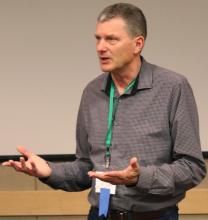Ken Quiring is convinced that the future of biblical literacy lies in video. This may be one reason why he and others like him have joined a growing movement known as “biblical storytelling
“We are reading print less and less, but we are doing more and more video,” said the pastor of Grace Mennonite Church in Brandon, Man., during an Assembly 2016 seminar entitled “Back to the future: Telling Scripture by heart,” whose goal was to “demonstrate why Scripture has become, for me, an oral, physical and multi-sensory experience.”
A member of the Network of Biblical Storytellers International (nbsint.org), Quiring has attended a number of “festival gatherings” that the network sponsors every August in the United States.
“Scripture stories are physical poetry,” said Quiring, adding, “You’ve got to use your body” to tell Scripture effectively.
How tellers use their bodies depends on the text. When preparing to tell a Bible story, Quiring looks for clues in the text. If a story includes a number of different places, he may point to locations on an imaginary map, or walk from one place to another. Physical actions in the story may be mimicked with hand gestures.
Quiring reminded participants that Bible stories were told orally long before they came to be printed text. Audiences would have participated in the telling, and maybe even in correcting the teller when a well-known story was told in a different way. Repetition in Bible stories provides opportunities for audience participation, he said, as in, “And there was evening, and there was morning” in the Genesis story of creation.
Every storytelling event is an interpretation. “You cannot tell scripture and not interpret it,” said Quiring. Gestures and tone of voice all add to the interpretation.
While some biblical storytellers don’t appreciate having their craft described as memorization, Quiring doesn’t have a problem with this, but he pointed out that the memorization process is not a purely cognitive one. He described what he does as a “full-body experience” of committing both text and movement to memory. “This is about muscle memory,” he said.
Quiring emphasized that even though biblical storytelling takes a little effort to learn, it is something anyone can do. To prove his point, he invited participants to try their hand at it. Working in pairs, they were given Bible texts to tell to one another.
People often think biblical storytelling is just for children, not for serious academics, said Quiring, noting, though, that this is definitely not the case. “Biblical storytelling is not divorced from academics; it partners with academics,” he said.
For more on biblical storytelling, read “Sounding the Scriptures.”
More about seminars at Assembly 2016:
Making a case for community
‘Young adults don’t need the church’
A vision for the MHC Archives and Gallery
The place of a ‘confession’ in church life
Laments and hopes for MC Canada
Exploring tough subjects and intense spaces
Good news sometimes comes in small packages
‘Partnering with God’s healing and hope’
Seeing dystopian heroines as prophets






Add new comment
Canadian Mennonite invites comments and encourages constructive discussion about our content. Actual full names (first and last) are required. Comments are moderated and may be edited. They will not appear online until approved and will be posted during business hours. Some comments may be reproduced in print.